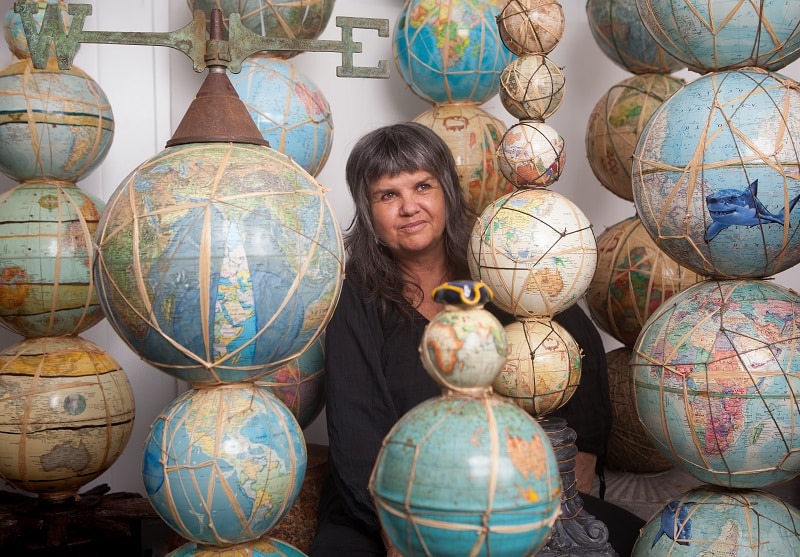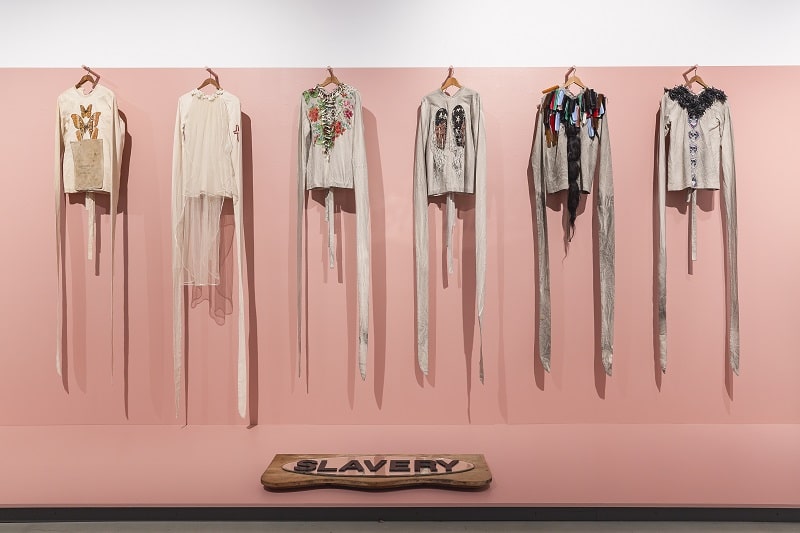‘Embracing Shadows’ celebrates three decades of art making by Wiradjuri woman and artist Karla Dickens in this survey exhibition comprising five major bodies of work, which chart the development of Dickens practice since graduating from Sydney’s National Art School in the 1990s.

Until 12 March, Dickensian Circus, Return to Sender, Cover Up, Women’s Business, and the newly commissioned Disastrous series are on display at Campbelltown Arts Centre in ‘Embracing Shadows’.
Dickens works from her studio in Lismore where she has lived for the past 20 years. In 2022, she experienced the floods that devasted Lismore and is witness to the ongoing impact it has on the community, the environment and wildlife – an experience she works through in Disastrous.
With a focus on issues of female identity, Aboriginal injustices, colonial histories, the environment, and the politics of Australian culture, past, present and future, Dickens expresses her personal and political concerns across painting, collage, text-based works, installation, photography, video, sculpture and poetic verse, producing works that are visually striking, materially innovative, and contextually powerful.
From the need to be resourceful during art school and from her love of collecting, Karla makes work and tells her stories using a wide range of found objects and materials – from fabrics and twines to hard edged work tools, as well as items of the unimaginable, such as canvas straightjackets and a cell door.
Reflecting on the idea that found objects have the potential to spark memory and connection within audiences, Dickens says, ‘I don’t want to punch them in the face with some of my ideas. I think found objects soften the blow but engage and pull the viewer into their own stories helping them connect with mine.
‘I especially like using farm objects and working tools. There’s a myth in this country that blackfellas are lazy and don’t work. I love using work tools because I think of my family and ancestors. This country was built on their backs as they worked – men and women.’

What motivates you to create?
I love being in the studio on my own. I feel safe in the studio, and I’m motivated to have time to connect to my practice and for some deep listening. When you’re trudging along and you get that moment of inspiration, it’s like a big dose of something meaningful. That’s what inspires me.
Can you explain how inspiration comes?
No, I just hope for the best really. I don’t know whether it’s the pressure of the past few years with Covid and feeling insecure in the world and living through a natural disaster. I feel like there are fewer times feeling inspired. At the moment I’m cherishing any of them. As a student at the National Art School, you don’t wait for inspiration you just go to work, and something will come, and something will happen. So, I know that if I’m in the studio I’ve got a good chance of connecting. Sometimes inspiration can happen at the kitchen table or washing up. Whenever it comes, I’m grateful.
You work with a wide range of found materials. Do you look for particular kinds of things?
Whatever takes my fancy. With this new work, I’m looking for things that would be appropriate, but after doing it for so long I only need to go in the backyard or the studio now to find pieces that work and fit. I love found objects. When I go to the tip or a garage sale I’m attracted to jars and tins of old nails and stuff. That reminds me of my grandfather. In using found objects I think people look at the work whether it’s fabric or other and their memories are triggered. I think when people’s memories are triggered their hearts open, and you have a chance of reaching them at a different level.
How does poetry and writing fit into your practice?
For many years I was working on heavy issues like sexual abuse and rape and neglect of First Nation women. I struggled with showing up at openings and people wanting artist talks about that trauma. I started writing the poetry to save myself from that experience of sharing it verbally. I realised that poetry really helped me pull the work together and put closure to issues and stories I was sharing. It seems like there is enough room in poetry to spell things out but still give people a bit of room to breathe.

Tell me about your new series of work ‘Disastrous’.
When I was 20, I joined Greenpeace in an attempt to act on issues that worried me. Being a blackfella you are aware of the environment. Over the years I have done quite a lot of work on the environment and koalas and now have the experience of living through one of the country’s worst natural disasters. I hadn’t worked for a few months after the flood as so much help and support was needed in Lismore and surrounding areas. I went back into the studio looking for some sanity and because I had a commitment to start the commission work for the survey show at Campbelltown. I needed to make work about my experience in that disaster trying to understand what had just happened. The trauma is still very much alive in our community, I think about life now as before and after the flood. I think about changes that need to be made. I think about and see the devastation that is happening, the ripple effect and the ongoing impact.
In this series there is Heartbreaking Records on the floods and a work about koala’s being extinct. They were annihilated in the fires, and they got sick with pneumonia in the floods, so there is work about those little fellas. There’s work about coral bleaching, droughts, and what cattle is doing to the country, mining, and global warming. It’s a body of work that I can continue with until I no longer make art, there is so much to explore and expose.
What has it been like to bring 30 years of work together for this exhibition?
It was a challenge especially last year in the middle of all that disaster. My suggestion was to get a big semi-trailer of art, show up, and just make an installation. But that was too terrifying for the gallery. I would have gone mental doing it, but it would have been fun.
We decided to create separate spaces for different times and bodies of work. There’s the Dickensian Circus and an iteration of Return to Sender, works from the Gallery’s collection, and an environmental room called Disastrous. Most of my focus and mental gymnastics went into the Women’s Business room where the works go back 30 years. It was a painful experience trying to pull it together and working out how to present it so that was readable to the audience. But it was the most rewarding.
Looking at that work my concerns are still the same. There are still women’s issues and I’m still looking at the history of the country. There is humour in the work, some people get it straight away and some people need a bit longer.
What are you working on next?
I’m working on a commission for Rising Festival in Melbourne. It’s about trauma in the landscape connected with the trauma of First Nations people. I’m also working on an exhibition at Maitland Gallery with Ben Quilty and Vincent Namatjira called Crown Land and I’m looking forward to starting that. I need to be in the studio where I can hide and think about life and the world.
Campbelltown Arts Centre is open from 10am to 4pm daily.